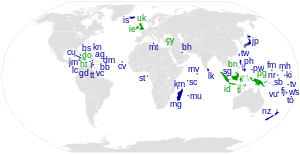
Back الحدود بين القارات Arabic Límits dels continents Catalan Límites de los continentes Spanish Limites entre les continents French Batas antara benua-benua di Bumi ID 대륙의 경계 Korean ഭൂഖണ്ഡങ്ങൾ തമ്മിലുള്ള അതിർത്തികൾ Malayalam Sempadan antara benua Bumi Malay Fronteira continental Portuguese 地球大洲边界 Chinese

Americas
North America
South America
Afro-Eurasia
Africa
Eurasia
Europe
Asia
Australia
Antarctica

Determining the boundaries between the continents is generally a matter of geographical convention. Several slightly different conventions are in use. The number of continents is most commonly considered seven (in English-speaking countries) but may range as low as four when Afro-Eurasia and the Americas are both considered as single continents.[1] An island can be considered to be associated with a given continent by either lying on the continent's adjacent continental shelf (e.g. Singapore, the British Isles) or being a part of a microcontinent on the same principal tectonic plate (e.g. Madagascar and Seychelles). An island can also be entirely oceanic while still being associated with a continent by geology (e.g. Bermuda, the Australian Indian Ocean Territories) or by common geopolitical convention (e.g. Ascension Island, the South Sandwich Islands). Another example is the grouping into Oceania of the Pacific Islands with Australia and Zealandia.
There are three overland boundaries subject to definition:
- between Africa and Asia (dividing Afro-Eurasia into Africa and Eurasia): at the Isthmus of Suez;
- between Asia and Europe (dividing Eurasia): along the Turkish straits, the Caucasus, and the Urals and the Ural River (historically also north of the Caucasus, along the Kuma–Manych Depression or along the Don River);
- between North America and South America (dividing the Americas): at some point on the Isthmus of Panama, with the most common demarcation in atlases and other sources following the Darién Mountains watershed along the Colombia–Panama border where the isthmus meets the South American continent (see Darién Gap).
While today the isthmus between Asia and Africa is navigable via the Suez Canal, and that between North and South America via the Panama Canal, these artificial channels are not generally accepted as continent-defining boundaries in themselves. The Suez Canal happens to traverse the Isthmus of Suez between the Mediterranean Sea and the Red Sea, dividing Africa and Asia. The continental boundaries are considered to be within the very narrow land connections joining the continents.
The remaining boundaries concern the association of islands and archipelagos with specific continents, notably:
- the delineation between Africa, Asia, and Europe in the Mediterranean Sea;
- the delineation between Asia and Europe in the Arctic Ocean;
- the delineation between Europe and North America in the North Atlantic Ocean;
- the delineation between North and South America in the Caribbean Sea;
- the delineation of Antarctica from Africa, Australia, and South America in the Indian, South Pacific, and South Atlantic oceans, respectively (referred to collectively by some geographers as the Southern Ocean or the Antarctic Ocean);
- the delineation of Asia from Australia in the Ceram Sea, Arafura Sea, Timor Sea, Halmahera Sea, and the Wallacean region of the Indonesian Archipelago
- the delineation of Asia from North America in the North Pacific Ocean.
- ^ R.W. McColl, ed. (2005). "continents". Encyclopedia of World Geography. Vol. 1. Facts on File, Inc. p. 215. ISBN 978-0-8160-7229-3. Retrieved 26 June 2012.
And since Africa and Asia are connected at the Suez Peninsula, Europe, Africa, and Asia are sometimes combined as Afro-Eurasia or Eurafrasia. The International Olympic Committee's official flag, containing [...] the single continent of America (North and South America being connected as the Isthmus of Panama).